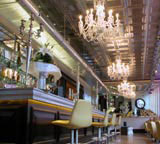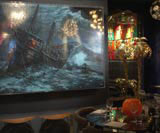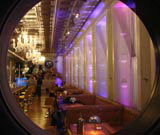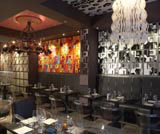Food for thought
A satisfying dining experience depends on more than just food. Bethan Ryder looks at how innovative lighting design can be the main attraction of a restaurant.

A satisfying dining experience depends on more than just food. Bethan Ryder looks at how innovative lighting design can be the main attraction of a restaurant
There is no better time to be a lighting consultant, designer or manufacturer. Technology, innovation and our own imaginations have boosted us light years on from the uninspired, recessed spot-lit commercial interiors of the 1990s, into a dazzling, radiant 21st century.
Of course, enlightenment may come in a variety of forms, but, within the realm of restaurant and bar interiors, there appear to be two different approaches that vie with each other. These could be typified as a simple, architectural ‘less is more’ approach versus a sparkling ‘more is glam’ maximalism, where lighting features become the star attractions. Perhaps, partly as a reflection of their purpose (dining by both day and night), the former trend is more prevalent in restaurant projects than bars.
Gerardo Olvera, senior designer at lighting consultant Isometrix, is working on two major New York restaurants that will open shortly – Buddakan and Morimoto – both owned by prolific Philly restaurateur Stephen Starr. Morimoto is designed by Tadao Ando, while Buddakan is the work of Liaigre, Gilles & Boissier, a group put together specifically for this project. They exemplify the trend towards ‘sophisticated, elegant lighting that emphasises the architectural features of an interior,’ according to Olvera.

Apparently, Starr looked to London restaurants for inspiration, particularly Christian Liaigre’s Hakkasan and Super Potato’s Zuma and Roka. At Morimoto, the exposed beams and structure of the former meat abattoir have been painted black. ‘This follows the Ando ethos of concealing everything wherever possible,’ says Olvera. ‘The lighting is about highlighting architectural elements of the concrete, glass and steel interior, such as the ceiling and a glass screen, featuring sake bottles [created by Ross Lovegrove], that organise the space.’
Similarly, at Canteen, the recently opened British-themed restaurant in London’s Spitalfields, the lighting is an understated affair in keeping with the pared-down utilitarian aesthetic. ‘Essentially, the design is about subtlety and simplicity, and, by focusing the lighting on the food and diners’ faces, this gives character to the restaurant,’ says Mark Simpson of Universal Design Studio, which designed the scheme. The approach was partly determined by the existing architecture – with the expanse of clear glazing affording the interior an abundance of natural light, the main challenge for Universal was to create an intimate atmosphere.
Lighting fittings were custom-made. ‘We wanted to focus the majority of the lighting at table level with additional accent only where needed,’ says Simpson. ‘So we created 3m linear pendants in a simple, folded, aluminium design to illuminate the long benches,’ he adds. Customised ceramic Hector table lamps, by BTC, fixed to linoleum surrounds, add a warm glow to window tables. ‘They’re analogous to the table lamps found in traditional railway carriages. The ceramic shade allowed light to illuminate faces of diners while still lighting the table surfaces and avoiding glare.’ The only superfluous light fittings are high-level GLS lamps and halogens that illuminate the oak panels at the rear of the restaurant. ‘These ensure that the colour rendering of oak is maximised and that the overall effect is warm and intimate,’ says Simpson.

Elsewhere, the glittering chandelier and digitally programmed changing-colour LEDs continue to reign. As often as not, the lighting is as much decorative as functional. At Ten West bar in London’s Ladbroke Grove, Shaun Clarkson has embellished his crazy multi-patterned ‘1950s tropical Hollywood lair’ interior with three antique 1920s chandeliers, sprayed red to match the decorative balustrade. Again, vast glazing means the space is flooded with natural light. To combat this, Clarkson has inserted a recessed thin red line of neon in the ceiling above the bar, and has backlit the bar to warm up and attract customers to this area.
In nocturnal venues, such statement lighting is de rigueur. Darren Orrow of lighting consultant Into Lighting has worked on several major restaurant and bar projects this year, most recently the Cuckoo Club in London and One Up in Glasgow, designed by Blacksheep and Julian Taylor Associates respectively. ‘They’ve been about bringing the glamour back to going out,’ says Orrow. ‘While we’ve continued with discreet light fittings – and not too many of them – it’s been more about creating some excitement with concealed LED details, using rich-coloured lights in changing hues of one colour, such as deep purples or reds, which add a sense of occasion.’
At the Cuckoo Club, the purple ceiling panel, likened by Blacksheep to a graphic equaliser or a fairground light, comprises glass domes, backlit by 1.2m strips of LEDs. ‘These project across it and create different effects. We calculated the light dispersion so that it seems as if there’s an individual light behind each dome,’ he explains.
Elsewhere, a dark double-height stairwell is lit by a giant mirror ball, suspended beneath a Philippe Starck-like over-sized lampshade. ‘Blacksheep didn’t just want a chandelier, so it devised this bespoke piece,’ says Orrow. ‘We lit it remotely, which is something we’ve started doing a lot, especially in areas where it’s difficult to change a light bulb. By shining a spot on a crystal chandelier, or something sequined or mirrored, the light bounces off around the room.’
At One Up, in Glasgow’s Exchange Square, the main challenge was to deal with the abundance of natural light streaming into the 17th century building. Julian Taylor Associates is a keen advocate of multiple light sources; high-level, mid-level, low-level and from ambient to task lighting.

Julian Taylor explains the One Up scheme, devised in collaboration with Into Lighting. ‘We designed table lamps that give no ambient light and purely throw light down onto the table. The use of chandeliers and light bouncing off the tin ceiling forms the major focus. The LED lights in the windows accentuate the window reveals, and frame the view into the square without letting too much light bleed in. Directional AR11 spots, at high level, give pools of light at floor level, while the bar-top candelabras provide candlelight.’
More is definitely more at Hassan Abdullah’s Annex 3 (pronounced Annex Trois) in London’s West End. Here the owner-designer revisits the opulent decadence of his previous projects, Les Trois Garçons and Loungelover, this time with an emphasis on 20th century objets trouvé and furniture. There is a dizzying array of lighting, from ornate gilt 1940s French pieces to 1970s Italian Perspex and neon light boxes. Pulsating at the heart of the space is a rainbow-bulbed fixture, salvaged from a fairground and encased in a clear Perspex box. ‘Everybody loves it,’ says Abdullah. ‘People take photographs of themselves next to it.’ He says that designers are specifying ‘more unusual lighting that is not mass produced, but bespoke, or rare’. Judging by these projects, the future, it seems, can only get brighter.
-
Post a comment



